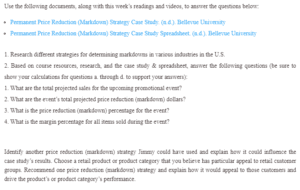Planning For Permanent Price Reductions-Markdowns
Strategies for Determining Markdowns in Various Industries in the U.S.
The value strategy is the first identified strategy for determining markdowns in the U.S. Notably; the value strategy attempts to balance item quality and price. Thus, the prices in this section are not too high or too low for brand equity. It means that target customers are not willing to spend more due to brand image, but at the same time, they are not willing to pay less while compromising quality. Second, the luxury strategy influences markdowns on products in the U.S. The assurance of a product relative to its brand greatly affects the pricing of this strategy. As a result, the goods tend to portray higher prices because higher prices denote greater regard for the brand, and consumers will be willing to spend on such products. Also, lower prices are disadvantageous because of the relationship with esteemed brand image and quality. Third, the budget strategy is commonly applied. It entails paying attention to customers’ concerns about product prices. Notably, this strategy targets customers willing to compromise important product aspects such as brand and quality for affordability (Chen et al., 2015). This method often results in higher product sale amounts at less per-unit profitability. Thus, the markdown advantage gained from this strategy becomes minimal.
Projected Analysis
The clearance of merchandise stock is one of the benefits of permanent markdown. It means businesses can perform a complete sell-through, gaining 100%. Notably, a schedule is considered when discounts ranging between 10-50% are yielded. Higher values are also considered because they help in the clearance of stock.
Total Projected Sales
Total sales are given by:
Dollar sales at 30% off + Dollar sales at 50% off + Dollar sales at 70% off
- = $54,391+$26,238+$19,235
- = $99,864
Total Projected Markdown Dollars
Total projected markdown dollars are given by:
Markdown dollars at 30% off + Markdown Dollars sales at 50% off + Markdown Dollars at 70% off
- =$23,311+$26,238+$44,881
- =$94,430
Markdown Percentage
The calculated total markdown dollars are divided by the total projected sales to ascertain the markdown percentage. The formula for the calculation is as follows:
Markdown percentage = Total markdown ($)/Total markdown dollars sales
- = (94,430*100)/99,864
- = 94.50%
Overall Margin Percentage
The overall margin/markup is given by dollar markup divided by total dollar sales.
Overall Markup/Margin=Dollar Markup/Total Dollar Sales
- = [(54391+26238+19235)-115,544]*100/ (54391+26238+19235)
- = -15,680/99684
- = -15.73% (Markdown)
A Markdown Strategy That Jimmy Could Have Used
Jimmy could have adopted the point-of-sale markdown in place of the permanent markdown. Notably, this could assist in a more flexible method of shifting product prices at the point of sale over a short period. An issue of a promotion offer could be done in which discounts should be provided, and once it is done, prices would rise again, ensuring a regular and proper stock clearance. The table below presents an example in which a discount of 50% is issued in the first week.
Figure 1: Issuing a 50% Discount
| SKU | Retail ($) | Initial Unit Buy | Units Sales at Full price | Unit sales at a 50% discounted price | Unit sales after discount (total price) |
| 75W SFL | 41 | 1000 | 500 | 300 | 200 |
| Dimmable 75W CFL | 88 | 1200 | 500 | 250 | 550 |
| Dimmable 60W CFL | 90 | 1200 | 500 | 300 | 400 |
| Dimmable 100W CFL | 71 | 500 | 300 | 100 | 100 |
| 100W CFL | 57 | 750 | 450 | 200 | 100 |
| 60W CFL | 48 | 750 | 450 | 200 | 100 |
From the observation, higher sales would be experienced due to lowered product prices. The discount would then be discarded while the retailer maintains 100% sales at a maximization facilitated through smaller markdowns.
Recommended Markdown Strategy
A sweater collection is an example of a product that can appeal to a specific group of customers. Appropriate timing and sale of sweaters to potential targeted clients by retailers would be the winning option. A price reduction strategy that considers a point-of-sale markdown strategy will be adopted. Essentially, this will ensure a continued flow of product sales during the time of making the promotional offer and even after the period. Ultimately, this will provide flexibility in reducing the markdowns to increase sales when there is a failure to achieve targeted sales in the promotion process.
References
Chen, M., Chen, Z. L., Pundoor, G., Acharya, S., & Yi, J. (2015). Markdown optimization at multiple stores. IIE Transactions, 47(1), 84-108.
ORDER A PLAGIARISM-FREE PAPER HERE
We’ll write everything from scratch
Question

Planning For Permanent Price Reductions-Markdowns
Use the following documents, along with this week’s readings and videos, to answer the questions below:
- Permanent Price Reduction (Markdown) Strategy Case Study. (n.d.). Bellevue University
- Permanent Price Reduction (Markdown) Strategy Case Study Spreadsheet. (n.d.). Bellevue University
- Research different strategies for determining markdowns in various industries in the U.S.
- Based on course resources, research, and the case study & spreadsheet, answer the following questions (be sure to show your calculations for questions a. through d. to support your answers):
- What are the total projected sales for the upcoming promotional event?
- What are the event’s total projected price reduction (markdown) dollars?
- What is the price reduction (markdown) percentage for the event?
- What is the margin percentage for all items sold during the event?
Identify another price reduction (markdown) strategy Jimmy could have used and explain how it could influence the case study’s results. Choose a retail product or product category that you believe has particular appeal to retail customer groups. Recommend one price reduction (markdown) strategy and explain how it would appeal to those customers and drive the product’s or product category’s performance.

